Introduction
This is the time of year when almost everyone in the northern hemisphere enjoys some kind of celebration, a lot of extra food ‘grazing’ and maybe even a few drinks to share with each other. Every December, we all seem to collectively rush in to the end of year as well as try to put the brakes on just about everything so that we can slow down and enjoy the season and spread a little cheer to folks around us.
Over the eons, a long list of different kinds of events have emerged, satisfying the wants, needs and desires of every culture and religion on the planet.
My ‘tradition’ seems to be an overwhelming desire to share what’s out there when it comes to understanding what other cultures celebrate during the holiday season. Even though there’s lots to share, what follows is barely a snapshot of the hundreds of different celebrations that happen some time between November and January each year in the northern hemisphere. Some take on a mythological spin, others are just about repeating something that you enjoy doing and look forward to when the family and friends have a little time off.
This is the time of year when we indulge, we splurge, we spend and we consume. Let’s slow down for a sec and explore the religion and mythological origins of why we do what we do every year.
I’ll contend that I see all of this as what I would call “Christ-myth”, a collection of stories and histories pilfered from other organized (and not so organized) religions around the world. If you want to explore the overlap of Christian traditions with other organized events / characters / activities that pre-date Christianity, check out this resource. For starters, there’s a lot of parallels with the miraculous and immaculate conception of the gods; stars that point out the time and place of a savior’s birth; angels, shepherds, and magi visiting an infant savior; the 25th of December as the universal birth date of gods; saviors who descend into Hell and much more.
If you have a sec, use the comments below to share some of your traditions and how they’re unique from the ones that I’ve listed. Also, I’m sure I’ve made many errors, be they dates, spelling or potential pronunciations, so please be kind with your feedback and I’ll try to incorporate corrections with updates and revisions.
In the meantime, Happy Holidays, Happy New Year and much, much more!
Where to start …
Solstice (Universal)
I’ll start with a quote from Joseph Campbell:
The dark night of the soul comes just before revelation. When everything is lost, and all seems darkness, then comes the new life and all that is needed. – Joseph Campbell, Reflections on the Art of Living: A Joseph Campbell Companion
Another quote:
“Celebrating the solstices was common to a lot of peoples in Europe and beyond, especially agricultural societies. And using fire and light is a common feature, because the winter solstice marks the darkest point in the year, from which the days get longer again,” explains Kathryn Lomas, an honorary research fellow in classics and ancient history at the University of Durham.
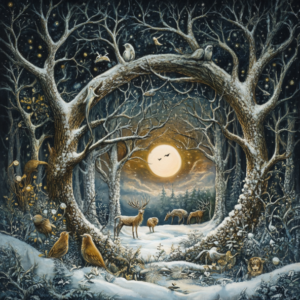 |
Winter Solstice begins December 21 and is often inaccurately described as the ‘shortest day of the year’ only because we almost always experience twenty-four hours to get around the sun, but because the world is tilted a few degrees, it’s when the Earth’s pole reaches the maximum tilt away from the sun, resulting in the least amount of daylight hours.
Technicalities, right? |
Most traditions in the northern hemisphere are variants associated with solstice because thousands of years ago, this was the time when the number of minutes of daylight started to increase, giving (agrarian) people hope that a new growing season would be upon them soon and that the hungry days of winter would soon be over. The reverse is true for the southern hemisphere.
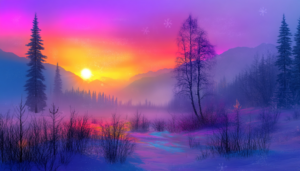
Research shows that humans may have observed the winter solstice as far back as 10,000 (or possibly even more) years, with monuments like Stonehenge, Chichén Itzá (Mexico), Anundshög (Sweden), Carnac (France), Big Horn Medicine Wheel (Wyoming, US), Chaco Canyon (New Mexico, US), Piedras Blancas (Antequera, Spain), the Pyramids of Giza (Egypt) and more.
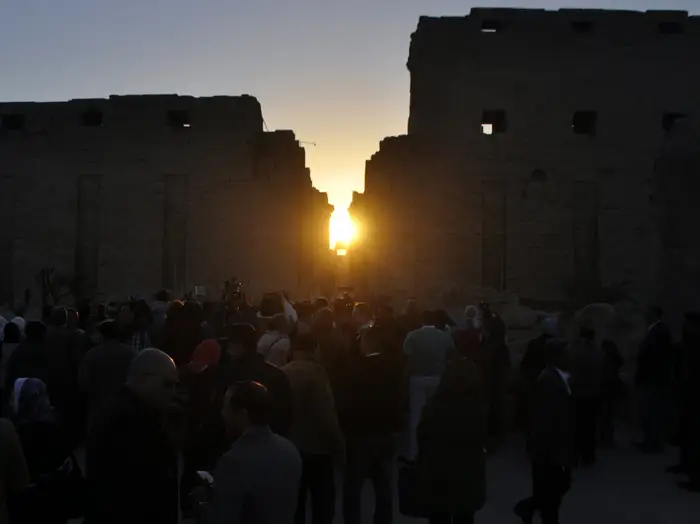
The sun peers through two massive walls that line the Temple of Karnak during the alignment of the winter solstice sunrise to the temple in the southern Egyptian city of Luxor on December 20, 2014.
Fire and light are traditional symbols of celebrations held on the darkest day of the year.
Yule (Nordic Countries)
The LOG is central to the Nordic observations associated with winter solstice.

Nordic Yule festival
Yule originated with the Germanic tribes, but spread across Europe through the Nordic countries and even had its influence with Ireland, Scotland and parts of England as the Angles and Saxons invaded the islands.
The word is related to a Norse festival called jol – maybe this is the word origin for ‘jolly’. Even Odin got into the act by acquiring ‘JOLNIR’ as one of his many names, and among his many duties was acting as a god of the dead.
And when you add in the fact that HOLLY was a central part of the festivities, it’s no wonder we’re told to have a ‘holly, jolly Christmas’!
In Sweden, goats became the animal of interest and massive creatures were constructed out of straw. Some were burned, but others were said to be used to pull a great chariot driven by Thor as he rode around the regions spreading cheer to all of the citizens. Sound familiar?
Of course, what’s a tradition without ritualistic sacrifices?
Some historians think that sacrifices were an important part of the observance, either to the gods and other supernatural beings (such as elves) or to the dead or both. In the harsh climate of northern Europe, most cattle were slaughtered because they could not be fed during the winter. Meat, therefore, was plentiful for a midwinter feast or to leave out as an offering. Some contend that the original festival was a sort of Norse Day of the Dead, with the god Odin as a major player. – Source: Britannica
So … it’s more than likely that the original jul activities were bloody and attendees likely got splashed a little.
In fact, it’s said that the Swedish people celebrated “midvinterblot” at winter solstice or “mid-winter-blood”. All kinds of sacrifices were made, possibly even human. Midvinterblot paid tribute to the local gods, with an appeal to release everyone from the grip of winter.
These days, the only sacrifice seems to be our diet. The Yule log of lore typically takes the form today as a Yule log cake, with swirls of white and brown layers.
Yule was one of the first celebrations to be absorbed into the Christian evolution of the holidays.
The Raven & Solstice (First Nations)
There are many variations on this story, but here are the most important components of the story,
A long time ago, the Raven was in the dark, as was everything else. Eventually, he discovered that a greedy old chief was hiding the sun.
The Raven loved the sun, like he loved all things that the Creator had given to the people, so he decided to disguise himself as a spruce needle. One day, the daughter of the greedy chief went for water and the Raven threw himself into the river and drank the needle.
She became pregnant and gave birth to a boy, but she didn’t know it was the Raven in disguise.
Things were going to plan for the Raven. Once he was a baby boy, he cried and cried until the greedy chief couldn’t take it any more and gave the sun to the Raven.
Once the Raven had the light, he turned back into himself and carried the light into the sky. From that point on, the Chief negotiated an exchange with the Raven and shared the sun over the course of the year.
Inti Raymi (South America)
The Incans (original inhabitants of areas now called Peru, Colombia, Chile) had a sun god named Inti. Raymi simply means ‘festival’, but it’s a nice coincidence with the root ‘ray’, right?
There was fasting involved and eventually everyone went up to the highest peak to wait for the sun to return. Beer, animal sacrifices and lots of fires were all part of the activities, making them seem very familiar with many of our current-day New Year’s events!
Even though the festival was banned by the Spanish colonists, it’s now one of the biggest events in South America.
By the way, because it’s in South America, the solstice festival occurs around June 21.
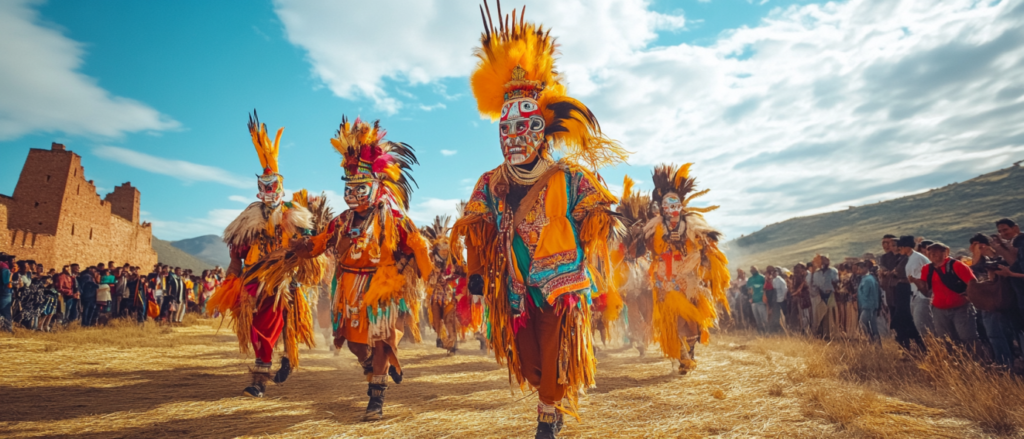
Dongzhi Festival (China)
Dongzhi translates to ‘winter’s extreme’.
Yes. Yes it is.
But only in winter do you get those intensely blue skies like Robert Redford eyes so why complain?
But I digress …
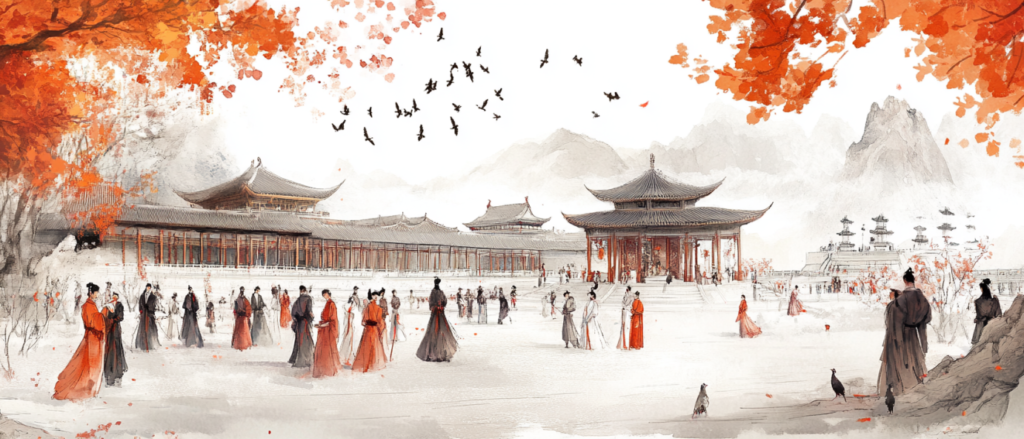
Dongzhi marks the beginning of winter and the celebration is closely connected to the philosophy of yin and yang.
Like all winter solstice festivals, it is a celebration of the victory of light over darkness.
It started more than 3,000 years ago during the Zhou Dynasty. People would take a break from their routine and honour their ancestors by burning joss (incense) papers.
The Dongzhi Festival has historically been associated with various agricultural activities in China, particularly in rural areas. It’s a crucial time to harvest winter crops, such as wheat, barley, and radishes.
Here’s what I like about it: people take a moment to pay respect to certain livestock and feed these animals special meals to celebrate the occasion.
Dumplings, pink and green ‘reunion balls’, hot pots and wontons are favourite food items during this time of year.
St. Lucia’s Day (Scandinavia)
In the 4th century CE, Lucia brought food to Christians who were imprisoned deep in Romans catacombs. She would wear a wreath with a candle on it so that both hands were free to carry food, creating an aura of light. In Sweden, Lussinatta, or Lussi Night, was celebrated on December 13. On this night, Lussi, a female demon or witch, was said to ride through the air with her followers. It was believed to be dangerous to be outside on Lussi Night.
Sister Winter
How about a little musical break. For years, musical artist Sufjan Stevens has created a massive library of holiday songs.
Sister Winter is a new favourite …
Toji (Japan)
The winter solstice in Japan, called Toji, has a few interesting customs associated with it. Traditionally, a winter squash called kabocha is eaten, one of only a few crops that would have been available in days of old. You’ll feel as if you’re on a warm winter getaway after taking a hot bath with yuzu citrus fruits. The bath is believed to refresh the body and spirit, ward off illness and soothe dry winter skin. Apparently rodents called capybaras love yuzu baths as well, and in a modern twist on the age-old tradition, some Japanese zoos will throw the fruit into the warm waters the animals soak in on the winter solstice.
Shab-e Yalda (Iran)
This ancient Persian festival, like many winter solstice holidays, celebrates the end of shorter days and the victory of light over darkness. Meaning “birth,” Yalda is marked by family gatherings, candles (originally fires lit all night), poetry readings and a feast to get through the longest night of the year. Nuts and fruits, including watermelon and pomegranates, are traditionally eaten—legend has it that eating the fruits of summer will protect you from illness in winter.
Soyal (Hopi, Pueblo, Zuni)
Soyal is the winter solstice ceremony of the Pueblo, Zuni and Hopi (Hopitu Shinumu) Indians, The Peaceful Ones.
The ritual ceremonially brings the sun back from its long winter slumber.
The longest ceremony on the ceremonial cycle may last up to 16 days and involves sacred rituals performed in underground chambers called kivas. Many ceremonies involve dancing and singing; the Kachinas (gods that guard over the Hopi) may even bring gifts to the children.
Lohri (India)
There are numerous origins of Lohri, a celebration which started in the mid-1800s. The main subject of Lohri is the conviction that Lohri is the enlightening celebration of Winter solstice. The key trait of Lohri is the bonfire. Illuminating the fire has been familiar in winter solstice festivals all through time. It implies the comeback of the longer days.
Lohri is an official holiday in Punjab, Jammu and Himachal Pradesh. The festival is celebrated in Delhi and Haryana but is not a gazetted holiday. Lohri is celebrated by Sikhs, Hindus and whoever wants to enjoy it.
Central to the event is the understanding that December/January is when the winter wheat needs more sunlight, so the origins are obviously agrarian in nature.

Santo Tomas Festival (Guatemala)
Although the Catholic church now observes the Feast of Saint Thomas on July 3, in Chichicastenango, Guatemala, the festival is still celebrated for a week leading up to the winter solstice of Dec. 21. Why? Likely because it’s a mix of the Catholic ceremony with native Mayan rituals that may have been timed to the solstice. Today, the feast features brightly colored traditional costumes, masks, parades, fireworks and music, making Guatemala a great winter destination. The highlight is the death-defying custom of the “flying pole dance”: climbing a 100-foot pole, tying on a rope and jumping off the top. Yikes!
Yalda (Iran)
‘Yalda’ means birth.
Yalda Night was one of the holy nights in ancient Iran and included in the official calendar of the Iranian Achaemenid Empire from at least 502 BCE under Darius I.
The longest and darkest night of the year is a time when friends and family gather together to eat, drink and read poetry (especially Hafez) and Shahnameh until well after midnight. Fruits and nuts are eaten and pomegranates and watermelons are particularly significant. The red colour in these fruits symbolizes the crimson hues of dawn and the glow of life.
Yalda marks the beginning of three 40-day periods before spring.
Saturnalia (Ancient Roman)
The ancient Romans celebrated Saturnalia, an event usually lasted about a month, beginning a few weeks before the Winter Solstice and ending early in the New Year.
Saturnalia was a party! ‘Hedonistic’ is the word most frequently used, but then, a lot things the Romans did seemed over the top.
Slaves were given their freedom (temporarily) and most businesses and schools were closed.
Mithras was the subject of admiration during these times. Mithras originated in Persia and was a Zoroastrian deity that ruled over the earth and was associated with the sun, justice, war, and contract (covenants). He was identified with the sun-god Helios. Sacrifices were made, usually to a bull. Of note is the relation of the bull to even more ancient creeds such as the Minoans. It’s suggested that sacrifices of this nature exhibit man’s control and dominion over animals, especially those related to the agrarian world.

This is where the cultural ‘blending’ begins: Persian traditions became Roman traditions; Roman traditions became Christian observations. Dates, activities, possibly even songs or food selections were supplanted over the older traditions, with the goal of making the ‘new and improved’ version more appealing.
In other words, even the ancients were great marketers and would ‘rebrand’ their observations as their own unique programs in order to instill a little inspiration and personality of the leaders of the day into them.
Chanukkah / Hanukkah (Jewish)
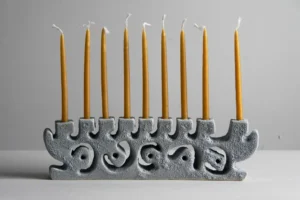
Hanukkah is an eight-day Jewish festival that commemorates the victory of the Maccabees over the Hellenists in 165 B. C. E. and the rededication of the Temple of Jerusalem. The holiday usually begins on the evening of December 21 (the 24th of Kislev on the Hebrew calendar).
Hanukkah is celebrated by lighting candles on the menorah, an icon that symbolizes each of the nights that the Maccabeans held the Temple in Jerusalem. Eight in all are lit.
The event commemorates the moments when King Antiochus of Syria commanded the Jews to abandon the Torah, their holy text. They rebelled, led by Judas Maccabeus (hence the group name), took the temple and cleansed their holy site.
The word ‘Hannukah’ refers to this idea of rebuilding and repairing their altar after it was desecrated by the invaders.
It is also called the Feast or Festival of Lights.
Popular foods include potato latkes, rugelach pastries, sufganiyot (deep-fried or jelly doughnuts) and much more.
Gift giving is an important element of Hannukah (as it is with most other traditions), where gifts are shared for each day of the festival.
Adam Sandler did a wonderful job of drawing attention to Hanukkah with his movie ‘Eight Crazy Nights’ and the song ‘Hanukkah’.
Festivus (TV)
“Festivus for the rest of us” – Seinfeld.
The event was inspired in 1997 by the popular show ‘Seinfeld’. Apparently, one of the staff writers, Dan O’Keefe had been celebrating variations of Festivus as early as 1966 when he was a kid.
What are the rules?
- Adorn an aluminum Festivus pole to be displayed in your home. …
- Serve a traditional dinner.
- During dinner, allow the Airing of Grievances. …
- Feats of Strength follows dinner and involves wrestling the head of the household. …
- Festivus Miracle – a frequent unimpressive miracle.
People are more than happy to continue with the tradition.
Univus (Universal)
OK … I made this one up. Years ago, I wanted to follow in the wake of the Seinfeld tradition, but they pretty much nailed it so I didn’t put any energy into it.
Chawmos (Pakistan)
Chaomos is the winter festival of the Kalasha (also known as Kalash Kafir) people, who live in valleys in the northwestern corner of Pakistan, about 20 miles north of Chitral. The festival honors Balomain, a demigod who once lived among the Kalasha and did heroic deeds. Every year, his spirit comes to the valleys to count the people, collect their prayers, and take them back to Tsiam, the mythical land where the Kalasha originated, and to Dezao, the omnipotent creator god.
The festival lasts for fifteen days and starts in December to usher in the new year with hopes of a better future for members of the community. The festival’s day coincides with the winter solstice.
Men and women don the traditional Kalash attire and participate in dances as traditional food is prepared.
Participants of the festival have to undergo a purity ritual by fire before they are allowed to enter the festival. The fire ritual is of two types, one for women and children and another for men.
This source lays out the details for each day of the festival.
Hari-Kuyo (Japan)
This is otherwise known as the ‘Festival of Broken Needles’.
In some parts of Japan, it’s held on December 8th, while in others, on February 8th. The day is traditionally celebrated by kimono makers who gather at the temple to lay needles and pins to rest in beds of soft tofu as a way of giving thanks for their service. They make prayers for improved skills as seamstresses/tailors as part of this 400 year old ritual that seems as funereal as it is celebratory.
It began about 400 years ago and still continues to this day.
Kwanzaa (African-American)
Kwanzaa is not associated with a religion or mythology.
Instead, it’s an annual celebration of all things related to African-Americans and was started in 1966 by Maulana Karenga who said:
His goal was to “give black people an alternative to the existing holiday of Christmas and give black people an opportunity to celebrate themselves and their history, rather than simply imitate the practice of the dominant society.”
It takes places from December 26 to January 1 each year, culminating in a communal feast called Karamu, usually on the sixth day.
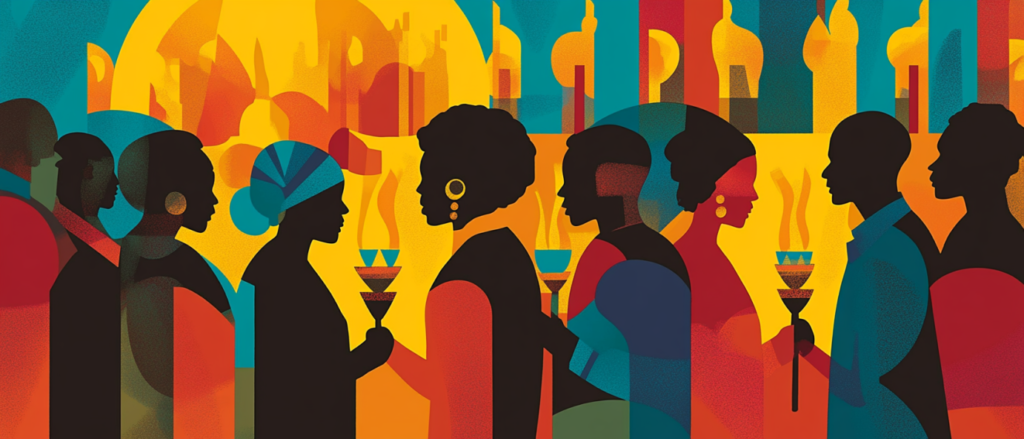
Karenga’s view on Christmas are somewhat controversial because he viewed the Christian tradition as being very white Europeans.
In time, the views were moderated in order to bring people in to the celebration.
Each of the seven days of Kwanzaa is dedicated to one of the principles, as follows:[20]
- Umoja (Unity): To strive for and to maintain unity in the family, community, nation, and race.
- Kujichagulia (Self-determination): To define and name ourselves, as well as to create and speak for ourselves.
- Ujima (Collective work and responsibility): To build and maintain our community together and make our brothers’ and sisters’ problems our problems and to solve them together.
- Ujamaa (Cooperative economics): To build and maintain our own stores, shops, and other businesses and to profit from them together.
- Nia (Purpose): To make our collective vocation the building and developing of our community in order to restore our people to their traditional greatness.
- Kuumba (Creativity): To do always as much as we can, in the way we can, in order to leave our community more beautiful and beneficial than we inherited it.
- Imani (Faith): To believe with all our hearts in our people, our parents, our teachers, our leaders, and the righteousness and victory of our struggle.
Diwali (India)
I’m including Diwali because it’s themes are in keeping with all of the others that I’ve explored, but the timing itself is usually a little earlier in the year. In 2024, it was a small coincidence to be on October 31, but in 2025 it will be observed on October 20 and then much later (November 8) in 2026.
The name comes from Sanskrit Deepavali, meaning “row of lights.” On the night of Diwali, celebrants light dozens of candles and clay lamps (called diyas), placing them throughout their homes and in the streets to light up the night.
The main celebration of Diwali takes place on the day of the new Moon when the sky is at its darkest, so a big part of the celebration revolves around light. Candles, clay lamps, and oil lanterns are lit and placed throughout the home, in the streets, in areas of worship, and floated on lakes and rivers. Fireworks are also set off on the night of Diwali—said by some to ward off evil spirits.
Another central theme of Diwali is family. Wearing their best new clothes, families gather together to eat sweets and other special foods, light diyas, and pray for their ancestors. Businesses are generally closed (or close early) on Diwali to allow workers to celebrate with their families.
There are usually five days of celebration, where different activities take place each day.
Bodhi Day (Asia)
Bodhi Day occurs on December 8 each year and celebrates the day the “Historic Buddha”, aka Siddhartha Gautama, Sakyamuni Buddha, achieved enlightenment.
According to tradition, Siddhartha shunned years of extreme ascetic practices and instead sat under Bodhi tree to just meditate. It was during these moments that he discovered the root of suffering, and how to liberate oneself from it. (Hint: freedom from want).
Individuals may choose to commemorate the event through additional meditation, study of the Dharma, chanting of Buddhist texts (sutras), or performing kind acts towards other beings. Some Buddhists celebrate with a traditional meal of tea, cake and readings.
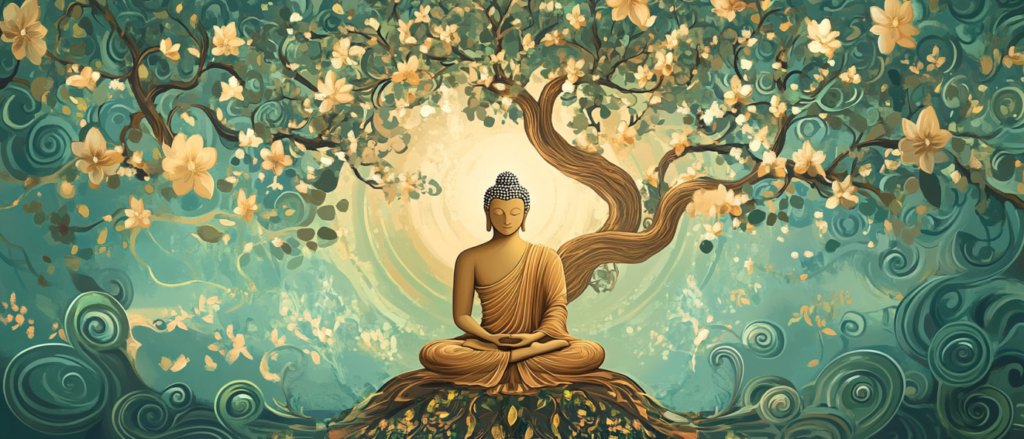
On a personal note, I named my original company ‘Bottree’ after the Bodhi Tree, hoping that the name would offer some kind of enlightenment for my business ventures. I don’t think it worked out.
Other names for Bodhi Day include Rōhatsu (Japan), Laba (China), Vesak Day.
Buddhist New Year (Tibet)
A few of the most widely known observances are described below, but you will find other customs across the Buddhist world. The Tibetan New Year, known as Losar, is a multi-day event in late January, February, or early March, as determined by the Tibetan lunar calendar.
To celebrate the New Year in Tibet, Buddhist monks create elaborate yak-butter sculptures (called torma) depicting a different story or fable each year. The sculptures often reach 30 feet high and are lit with special butter lamps. These figures may be pigmented with different colours to add to the styling but they are a symbol of the impermanence of all things. Awards are given for the best butter sculptures.
Buddhists also decorate trees, albeit for a different occasion—Bodhi Day. This holiday, celebrated in December, marks Lord Buddha’s enlightenment and the attainment of Nirvana.
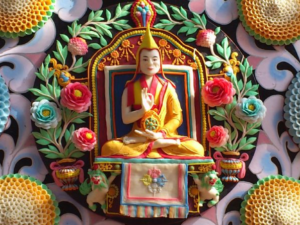
Christmas
I saved the biggest for last.
Obviously, entire libraries (and server farms) are filled with everything we need to know about Christmas, so I won’t elaborate on everything and anything I find about this giant holiday and observation in the Christian religion.
What I’d like to do is explore some of the more unique elements associated with Christmas that might help you up your trivia game knowledge.
The Birthday
See below for a comment about the ‘Three Kings’.
Of course, Jesus Christ is said to have been born on December 25, but so were the following:
- RA – A Nubian (Egyptian) God, born 25th December, by a Virgin around 3,000 YEARS BCE.
- HORUS – A Nubian (Egyptian) God, born 25th December, by a Virgin around 3,000 YEARS BCE.
- BUDDHA – A Nepal God, born 25th December, by a Virgin around 563 BCE.
- KRISHNA – An Indian God, born 25th December, by a Virgin around 900 BCE.
- ZARATHUSTRA – A Persian God, born 25th December, by a Virgin around 1,000 BCE.
- HERCULES – A Greek God, born 25th December, by a Virgin around 800 BCE.
- MITHRA – A Persian God, born 25th December, by a Virgin- 600 BCE.
- DIONYSUS – A Greek God, born 25th December, by a Virgin around 500 BCE.
- THAMMUZ – A Babylonian God, born 25th December, by a Virgin around 400 BCE.
- HERMES – A Greek God, born 25th December, by a Virgin around 200 BCE.
- ADONIS – A Phoenician God, born 25th December, by a Virgin around 200 BCE.
The Banning of Christmas
What?!?!? Ban Christmas? I wouldn’t dare suggest a thing, but the Puritans of Massachusetts sure wanted to get rid of holiday excess:
In 1659 the Massachusetts General Court declared the celebration of Christmas to be a criminal offense. What the Puritans were trying to suppress was a season of excess rooted in the ancient agricultural cycle – rowdy public displays of eating and drinking, mockery of established authority, aggressive begging, and boisterous invasions of the homes of the wealthy.
Feast of the Immaculate Conception
This is a Catholic celebration that occurs on December 8 each year although it seems to miss out on the math associated with the gestation period of a human being brought to term.
The Feast may have started as early as the 5th century CE in Syria.
In many countries of the world, the date is considered a holiday.
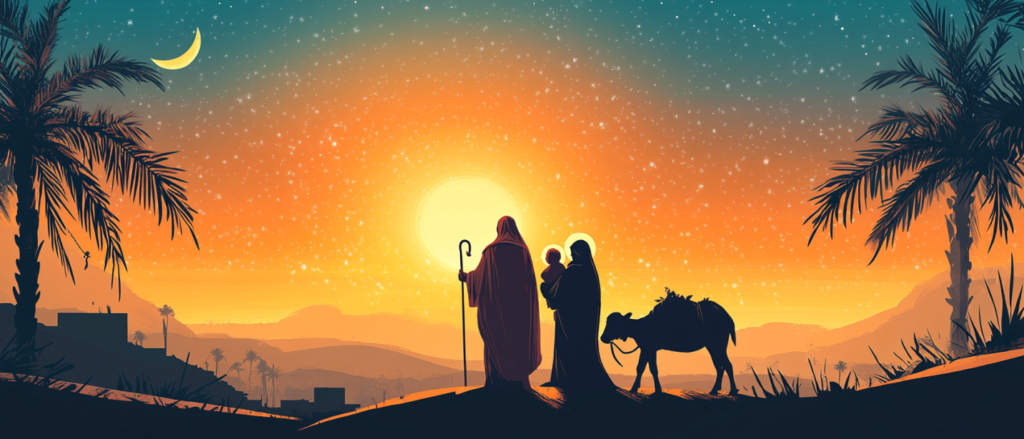
The Tree (European)
I’m putting my foot down. It’s a tree. It’s not a ‘Christmas’ tree because it’s not Christian.
The symbolism is the tree that’s typically used during the Christmas season is associated with everlasting life, or evergreens, hence the reason for using conifers like pine, spruce and fir trees for your livingroom.
According to Atlas Obscura, the original ‘Christmas tree’ – a conifer that was decorated during the holiday season – originated in Riga, Latvia.
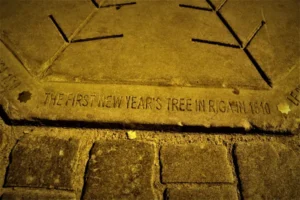
Apparently,
The Brotherhood of the Blackheads was a guild of professional merchants and traders that banded together in the 14th century, and remained active in Latvia and Estonia right up through the middle of the 20th century. They were known for their twice-yearly holiday celebrations, including the Christmas to New Years season. It’s said that the Brotherhood put a fir tree in the square, festooned it with paper flowers, sang and danced and cheered the season, then lit the whole thing on fire.
In modern days, some people debate the idea of having a real vs a fake (plastic) tree. Either way, it feels like we’re damned if we do, damned if we don’t because there are anywhere from 100 to 150 million trees cut down every year for Christmas, but probably about 5-6 times that being grown for the same purpose at any time. Plastic trees are permanent, but originate from oil products.
The tradition of having a tree in your house goes back about 500 years, with some sources suggesting it was a European Christian effort to reproduce the Garden of Eden in the middle of winter.
Adorning The Tree With Decorations
I don’t know what traditions exist out there, but in our household, we almost always find a nice decoration when we’re traveling. Each year, as we put out our decorations, we’re reminded of our holidays not just in the moment, but those that we enjoyed in the past. We have decorations that include the Beatles (our trip to UK in 2018), a sea turtle (Hawaii), Pokemon (NYC, 2014) and more. There are also many that my wife and son made when they were little.
From Lamprey to Christmas Treat (Portugal)
Have you ever seen a lamprey, especially up close?
I have NOT and I really don’t want to.

Lamprey eels, just hanging out. Source: NOAA
One day, I’d love to just focus on FOOD around the world experienced during the holiday season, but that would be a whole other project.
That said, I can’t ignore this one. During the season, another treat will appear: a curved, eel-shaped mound of egg yolks, sugar syrup, and almonds that will stare at diners with candied-fruit eyes and a big smile. This is lampreia de ovos, a dessert that glorifies a 360-million-year-old sea monster.
This is a little bit of one of those WTF moments, but it’s importance goes hand-in-hand with the fact that at one point, they were in short supply, the wealthy decided to covet them and they therefore became common ornaments around this time of year as people wanted to mimic the prestige associated with serving fresh lamprey eel.
Whatever floats your boat, I suppose 🙂
Hide the Christmas Pickle!
Get your mind out of the gutter!
The Christmas pickle tradition involves hiding a glass pickle ornament deep within the branches of your Christmas tree. According to this custom, the first child to spot the pickle on Christmas morning receives an extra gift or gets to open the first present. Though often thought to be an old German tradition, this festive hide-and-seek game actually originated in America during the late 1800s, when Woolworth stores began importing glass ornaments shaped like fruits and vegetables from Germany.
Gift Giving (Universal)
Almost all traditions have gift giving as an essential part of the holiday season, but the Three Wise Men get a LOT of credit for having started the act of exchange when Christ was born.
What is Myrrh anyways?
A fun twist on the “Secret Santa” tradition is known as “White Elephant”. In this tradition, all gifts are placed in a central location. Numbers are drawn for when each participant will choose a gift. Recipients have the option to take a previously opened gift from another person or test their luck by selecting an unwrapped gift. The “White Elephant” concept provides a more fun and interactive environment for a gift exchange.
Krampus (European)
Alpine countries like Austria have a legend that a devil-like creature called Krampus joins their St. Nicholas festivities on December 6. Children are asked for a list of their good and bad deeds: Good children are rewarded with sweets, apples, and nuts, and bad children worry what Krampus might bring on Christmas morning.
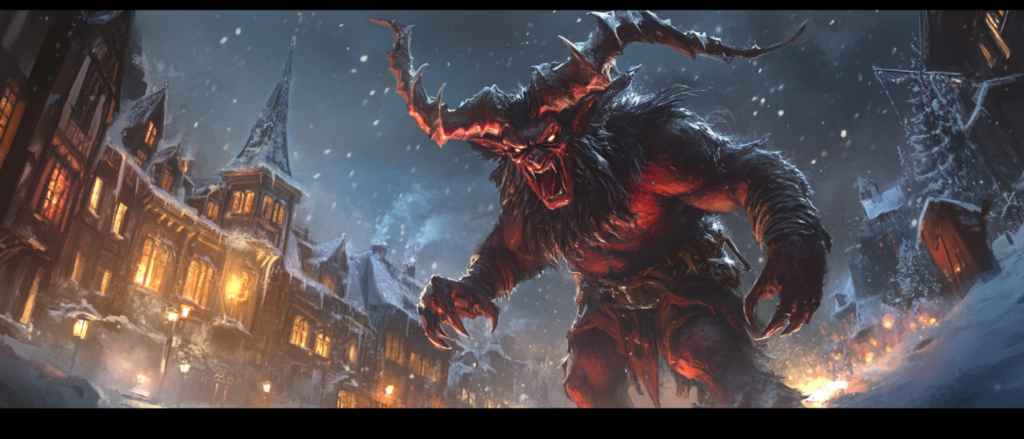
Perchten
In the wake of Krampus comes Perchten.
In contrast to Krampus, the Perchten disguise themselves with costumes made of corn husks instead of fur. According to ancient tradition, the Perchten are supposed to drive away the evil winter spirits with their bells, making them auspicious protectors.
These events normally take place on December 5 each year.
In the Tyrolean lowlands, in Breitenbach and the neighbouring villages of Angerberg and Mariastein, lies the origin of the eerie custom. At least that’s what the people of Breitenbach claim. In the local dialect, people speak of the “Peaschtln”, who are out and about every year around 5th December. A group is referred to as a “Pass”.
Las Posadas (Mexican)
Las Posadas is a popular Mexican tradition that takes place during the nine days before Christmas, from December 16 to 24. It’s a religious celebration that commemorates the journey of Joseph and Mary from Nazareth to Bethlehem in search of a place to stay for the birth of Jesus. The name “Las Posadas” translates to “the lodgings”.
It’s common to break pinatas during this time.
People reflect on humility, charity and generosity.
Spirit Sweep (Norway)
In Norway, it is a tradition to hide brooms inside cupboards on Christmas Eve. This tradition comes from an old superstition that claimed that on the night of December 24th, witches and spirits would wake up to go out and roam, and that if they found a broom, they would steal it and use it to fly over the city and do evil.
Tolling the Devil’s Knell (Dewsbury, England)
About ten o’clock on Christmas Eve, ringers gather at All Saints church, Dewsbury, Yorkshire, to Ring the Devil’s Knell. The church’s tenor bell, called Black Tom of Southill, is rung once for every year since Christ’s birth. It is called the Devil’s Knell, or more colourfully, The Old Lad’s Passing Bell, because of the belief that the Devil died when Christ was born. The tolling is carefully timed to finish on the stroke of midnight. A local legend explains the custom as established by one Thomas de Soothill, in penance for murdering one of his servants five or six hundred years ago.
A Cola Company & Santa Claus
There are LOTS of different traditions associated with Christmas and Christians.
Every year the debate rages about whether or not a certain cola company co-opted the image of Santa Clause (or created it).
The closest original image of our modern-day Santa Clause comes from 1862 when American Civil War cartoonist Thomas Nast drew a little elf supporting Union soldiers at Christmas.
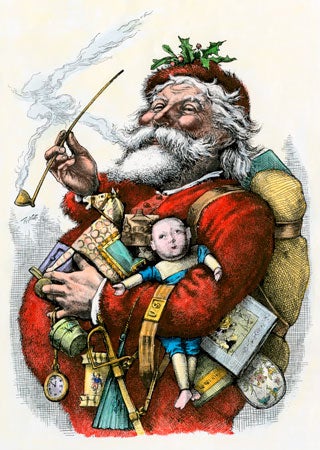
‘Santa’
Starting in the 1920s, the certain cola company started using a red and white clad elf as Santa Claus and every year, they kept rolling out new versions.
Humour me for a sec while I remind us all about waste.
In recent years, companies that sell liquids – water, cola, juice, etc – really aren’t making liquids any more. They’re making plastic. Nearly 50% of all plastic generated and tossed away every year is a result of bad packaging related to just SIXTY companies around the globe.
Just … try to stop buying disposable plastic stuff. It might be a little hard around the holiday season, but maybe make it a New Year’s resolution?

Twelve Days of Christmas
Twelve is a common number with many cultural traditions. I personally this is because there are twelve discernable astrological signs in our immediate universe.
Twelve is also the number of days between December 25 (the birth of Christ) and January 6 (the Feast of Epiphany, or when Jesus was baptized).
Here are the Twelve ‘things’ that are part of the song:
- Partridge = Jesus Christ, the Son of God
- Turtle Doves = The Old and New Testaments
- French Hens = Faith, Hope and Charity, The Theological Virtues
- Calling Birds = The Four Gospels and/or the Four Evangelists
- Gold Rings = The First Five Books of the Old Testament
- Geese A-laying = The Six Days of Creation
- Swans A-swimming = The Seven Gifts of the Holy Spirit
- Maids A-milking = The Eight Beatitudes
- Ladies Dancing = The Nine Fruits of the Holy Spirit
- Lords A-leaping = The Ten Commandments
- Pipers Piping = The Eleven Faithful Apostles
- Drummers Drumming = The Twelve Points of Doctrine in the Apostle’s Creed
If you add up all of the gifts through the duration of the song, you get 364, or the number of days in a year (with the exception of leap years). Please tell me this is a coincidence 🙂
Boxing Day (England)
Boxing Day occurs every year on December 26. Not only is now one of the biggest retail events in North America (just after Black Friday, which occurs after the US Thanksgiving in November), it’s a quintessential British thing. A lot of people still scratch their heads about why this is a ‘thing’ but the suggestion is pretty obvious: it’s when you box up all of your crap Christmas stuff and get on with the New Year.
I like the idea that this is when people ‘boxed up’ all of their unwanted items and donated what they didn’t want to keep to local charities. This seems much more in keeping with the holiday idea of selflessness and more about caring for others.
Finally, what’s December 26 in North America without football?
Three Kings Day (Universal)
Three Kings Day is a celebration of the biblical tale in which the Three Kings (Melchior, Caspar, and Balthasar) visit baby Jesus after his birth. It is celebrated on January 6th which is 12 days after Christmas day. According to the Gospel of Matthew, the three kings traveled to Bethlehem to bring the baby Jesus gifts of gold, frankincense, and myrrh.
Today, people from countries all over the world celebrate this day. In Mexico, children are told to leave their shoes by the door of their house so the three kings can visit and leave them presents. Many bakeries make rosca de reyes which is a sweet bread meant to represent a king’s crown. The bread usually has several baby figures inside. Anyone who gets a piece of rosca with the baby figurine is expected to host a party on Día de la Calendaria which is February 2nd.
Three Kings Day is also referred to as Epiphany, but not of the Taylor Swift variety:
There’s an element of mythological / solstice interpretation to this. Since solstice occurs December 21, it’s said that the ‘Three Kings’ are the darkest nights that follow solstice and then on the fourth day, we have December 25, the ‘birth’ of the son, or when it starts to appear just a little earlier and stay a little later each day.
Saint Nicholas Day
Many look at Saint Nicholas as being the original version of Santa Claus, but the history doesn’t compare well to the current version.
Saint Nicholas was born in the village of Patar, located on the southeastern coast of modern-day Turkey on March 15, 270 CE. He was known for selling all his possessions and giving his money to the poor. Raised as a devout Christian, St. Nicholas dedicated his whole life to serving the sick and suffering and is the patron saint of children and sailors.
Saint Nicholas Day actually originally took place on December 6 and in the 20th century, things have become a little blurred between Christmas and anything else.
Ndocciata (Italy)
This event takes place in Agnone, Italy on Christmas Eve.
It is a fire ritual believed to be one of the largest in the world.
Hundreds of citizens carry large torches, with at least one person carrying up to thirty torches weighing ten pounds each.
La Befana (Italy)
La Befana is often depicted as an old woman or witch-like figure who flies around on a broomstick. She is sometimes called “the Christmas witch” because of her costume and association with Sabine, who was sometimes referred to as a good witch.
La Befana leaves gifts in children’s stockings or shoes, such as candies, toys, or sweets for good children, and coal for bad children. The tradition of giving both a gift and coal acknowledges that children can behave both well and badly throughout the year.
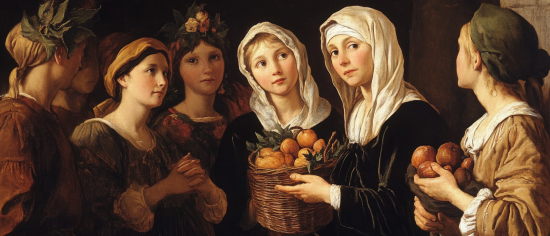
Shoe Toss: Single or Married? (Czech Republic)
On Christmas Eve, in the Czech Republic, single women stand with their backs to the front door of their house and throw a shoe over their shoulder. If the tip faces the door, it means that they will get married next year.
Yule Cat (Iceland)
Thanks again to Atlas Obscura which really seemed to outdo themselves this year when it came to reporting on different customs around the world.
The Icelandic ‘Yule Cat’ eats children if they’re caught without new clothing and has been inflated to the size of many homes in Iceland.
I have to admit that I’ve never been big on cats and this legend certainly doesn’t win me over.
To read more about the history, check out Atlas Obscura.
Night of the Radishes (Oaxaca, Mexico)
The origins of the Night of the Radishes date back to the end of the 19th century. At that time, a Christmas Market was held in Oaxaca’s Zocalo each year on Christmas Eve.
This market sold dried fish and shrimp, herbs, and of course vegetables and other items Oaxaqueños needed to prepare Christmas dinner.
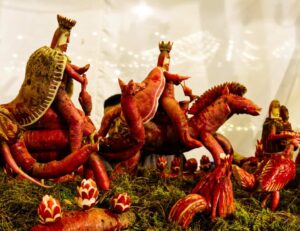
As one legend goes, the Oaxaca radish crop was so abundant one year that some radishes were forgotten and not harvested on time. When the radishes were dug up months later, they were very large and resembled different figures.
The giant radishes were brought to the Christmas Eve Market in Oaxaca, where they were then carved to draw the attention of the clients to the vegetable stands. The carved radishes were a hit and in 1897, the mayor proposed an annual radish festival in Oaxaca with a prize for the top contestants.
Caga Tió (Catalonia, Spain)
This one beats pretty much any tradition I’ve encountered in this quest to find some of the more unusual celebrations around the world. It’s certainly more odd than the whole ‘Elf on a Shelf’ routine that’s picked up in popularity over the last decade or so.
The Caga Tió (or Uncle that Shits) originated in the Catalonia region of Spain. Children decorate a log with a blanket and a mask, then they feed and beat it for days while singing a song. It’s kind of like a pinata, in that on December 24, it eventually ‘poops out’ gifts of sweets, chocolates and small gifts for the children. It is usually a large piece of wood with a smiling face painted on one end, and two or four stick legs. It’s often decorated with a red Catalan barretina, or traditional red sock hat.
The Caga Tió tradition is also celebrated in Majorca, Occitania (Southern France), and Andorra. In Aragon, it’s called Tizón de Nadal, Toza de Nadal, or Tronca de Nadal.
Wassailing The Apple Trees (Britain)
The word “Wassail” comes from “Waes Hael”, which means “be well”.
The purpose of wassailing, or blessing apple trees, is to encourage the spirits into ensuring a good harvest the following season. It takes place on the twelfth night after Christmas and involves a visit to a nearby orchard for singing, dancing, drinking and general merrymaking.
Participants gather around a tree, sing traditional songs, and make noise to scare away evil spirits. They drink cider and pour it over the tree’s roots and also hang cider-soaked toast from the branches of the trees, mainly to attract good spirits. Lots of noise is made with the use of pans and sticks, while people dance to celebrate.
Wigilia (Poland)
Wigilia is a traditional Polish Christmas Eve supper and vigil that takes place on December 24th. It’s considered the most important meal of the year in Poland and is a time for celebration with close family.
The loose translation of Wigilia is ‘Christmas Eve Vigil’.
Book Exchange (Iceland)
Jólabókaflóð – or ‘Christmas Book Flood’ – occurs on Christmas Eve every year and involves the exchange of books.
The recipients then spend time reading their new books either together or in quiet.
Just in case you wanted to know how to pronounce it: “yo-la-boke-uh-flowed.” The initial ‘J’ as more of an ‘I’ sound. It’s almost like you’re saying “jolly book flood”,
Russian Winter Festival
This festival in Moscow runs from December 25 to January 5.
his festival pays homage to Russian Christmas, Russian New Year, and Svyatki (Russian Christmastide) celebrations and traditions customarily observed during winter.
While there are other Winter Festivals across Russia, the popularity and size (thanks to the city’s resources), make the Moscow version of the Russian Winter Festival one of the biggest and best to attend.
Feast of the Ass
Again, get your mind out of the gutter!
The Feast of the Ass occurs on January 14 and is a tribute to the donkey that carried the Holy Family into Egypt after Christ’s birth.
This feast may be a Christian adaptation of the pagan feast, Cervulus. Carl Jung had this to say about it:
It took place on the kalends of January and was a kind of New Year’s festival, at which people exchange strenae (étrennes, ‘gifts’) dressed up as animals or old women, and danced through the streets singing, the applause of the populace. According to DuCange (s.v. cervulus), sacrilegious songs were sung. This happened even in the vicinity of St. Peter’s in Rome.
End the Waste
There’s no time like the present to start enjoying the holidays, but in a greener way.
Each year, millions of tonnes of waste are generated as a result of holiday excess. Experts suggest that our buying and consuming habits surge about 30-40% more in December than they do the rest of the year. Paper, trees, food waste, packaging and other one-time components of the holidays usually wind up in landfill sites across the globe. Most Christmas wrapping paper is NOT recyclable because of the treatment that’s used, so avoid the shiny, waxy products and stick to 100% recycled paper products.
- Reconsider the tree. If you already have a plastic tree, make it last as long as you can. If you want a live tree, you can try experimenting with buying a smaller tree that can be planted in your yard, but that only goes so far, because most people can’t make a small tree last another 4-5 months.
- Be sure to re-use all of your decorations and pack them away for the following year.
- Use paper from advertisements and flyers for your wrapping paper or do what we do: collect all of your paper bags and just tie the top with a ribbon and reuse them next year.
- Introduce more vegetarian meals to your holiday grazing: it’ll be better for you AND the planet. Meat accounts for billions of unnecessary animal deaths per year and anywhere from 30-40% of all greenhouse gas emissions.
All it takes is a tiny bit more planning to reduce the volume of waste this year.
Our planet will thank you for it!
Unique Christian Saint Days
Apparently, there are more than 10,000 saints in the Christian pantheon, so I’ll just touch on a couple that struck me as interesting. Feel free to add your favourite saint in the comments, but remember that the goal is to include only those related to Christmas or who’s observations occur during December or January.
- St. Spyridon Day – Dec 12 or 14. Spyridon is the patron saint of potters (from the miracle of the potsherd, above) and of the island of Corfu where he is called “Αγιος Σπυρίδων ο πολιούχος”, “Saint Spyridon, the Keeper of the City”, for the miracle of expelling the plague (πανούκλη) from the island. He is also the patron saint of Piraeus where he is celebrated and honored every year.
- St. Sava’s Day – Jan 14 or 27. Serbian. He is widely considered one of the most important figures in Serbian history.
- St. Stephen’s Day – Dec 26. Saint Stephen was a deacon in Jerusalem who was stoned to death in 36 CE for his service to the poor and for spreading Jesus’s teachings. Traditions include eating leftovers (of course), selecting cakes and blessing the first bread of the year.
- St. Thomas Day – Dec 21. Thomas was one of Christ’s Apostles and doubted (hence the phrase ‘doubting Thomas’) the resurrection of Christ. Apparently, when Christ returned, Thomas was converted into a believer.
- St. Thorlak’s Day – Dec 23 – I just love the name. Thorlak is from Iceland. He’s also the patron saint for people with autism spectrum disorder.
- St. Modesto’s Day – Dec 16. Patron saint of farmers in Greece. His feast day is celebrated with various rituals in honor of farm animals. In Lemnos, kollyva (cooked wheat berries) and holy water are mixed with their fodder, while in Lesbos, the holy water is sprinkled on the fields to ward off locusts and disease. For horses and oxen, December 18 is a day of rest.
The Women of Christmas
This whole subject demands a little more research and since I’ve run out of time for the holiday season (as I type these comments, it’s January 20, 2025 or Martin Luther King, Jr. Day).
As I compiled this massive list of different activities and events, I noticed a transition of sorts happening with the influence of different religions:
- The worshipping of inanimate objects such as the sun, moon or animals up to the introduction of monotheistic traditions;
- The imposition of monotheistic religions (mainly Christianity) on these traditions and activities.
The Son replaced the Sun.
That’s OK I suppose, but in the process of the Son replacing the Sun, we went from a very neutral or possibly even matriarchal structure to a very definite patriarchal society and construct.
As a result, we lost all of the female characters that were so dominate in our society before the big sweep happened somewhere around 6,000 BCE.
We still have a few, like La Bufana that I mentioned above, but I feel that we’re sorely lacking in diversity with the various stories and legends concerning the cosmic changeover that we experience and witness every year.
You would think the birth of a New Year would have a mother involved.
I did a little digging and I found a couple of articles that I’ll write about:
- The Lost Female Figures of Christmas
- In the shadow of Santa Claus: (re)discovering female figures of the year-end holidays
- The Women Who Gave Us Christmas
Here’s where I feel like a schmuck. I’m going to stop here for the moment because I want to dedicate more resources and effort behind these all-important stories.
I want to give credit where credit is due and make sure that we all enjoy a full deep-dive with respect to how are holidays were once shaped by women and not men.
New Year’s Eve / Day (Universal)
December 31. This is one of those seemingly universally accepted transitional dates.
Everyone around the world usually do something to acknowledge New Year’s Eve and New Year’s Day. Even U2.
I think we all know what this date is all about, besides expensive cabs or Uber rides with surge pricing; loud fireworks; lots of bubbly and dancing.
Once again, US college football is a common event on New Year’s Day, with a number of games spread out across the country as ‘Bowl’ games: Rose, Cotton, Orange, Sugar.
It’s common to make promises to yourself on New Year’s Day, but less so to actually stick to them.
Cultures around the world have different names for it. Here are just a few examples:
- Japan: Ōmisoka or Oshogatsu
- People clean house and purchase new clothes for children. Gifts are exchanged and personal debts are paid off. TV shows and other entertainment are the focal point of the nation, and at midnight priests in Buddhist temples strike the bells 108 times, a reminder of the 108 (yikes!) frailties or sins in Buddhist belief. People eat mochi cakes
- Scotland: Hogmanay (pieces of oat cake are handed out to kids).
- Mummering: mainly Newfoundland
Auld Lang Syne
Nobody seems to know what it means.
I once had a friend who would ask ‘why would you sing should OLD acquaintance be forgot?’
As in, I don’t know you anymore and I don’t like you and, well, I’m moving on.
The famous Canadian band leader, Guy Lombardo, would lead the orchestra as midnight got closer and closer and then everyone would descend on each other to kiss and be drunken fools, getting mixed up confetti and other decorations.
So … what does it mean?
It starts with the Scottish. ‘Auld Lang Syne’ translates from Gaelic to English as ‘Old Long Since’ or long, long ago. Or ‘time gone by’ or even ‘once upon a time’.
The poem was written by the Scottish bard, Robert Burns. It oozes nostalgia.
Let’s think about what happened in the last year and embrace all that was good and reflect on how we can make ourselves better.
Here’s a link to the full lyrics and a nice story by Atlas Obscura about Guy Lombardo’s experience with the song, especially in Manhattan.
San Silvestre Races (Brazil)
Saint Sylvester / San Silvestre was a bishop of Rome in the 4th century, CE.
Many cultures celebrate his existence on December 31 each year, with others on January 2.
To mark this saint, folks engage in races or marathons, the first of which was held in São Paulo, Brazil in 1925. Other countries include Spain, Argentina, Colombia, Costa Rica and Mexico.
Mummering (Newfoundland)
Mummering occurs in many places, but I was first introduced to the idea by a friend from Newfoundland and their take on the tradition is quite unique.
It’s basically a group of folks that get together at some point over the holidays, but usually New Year’s Day. Hangovers my be part of the norm and disguises are a must. The activity harkens back to the Joseph Campbell notion about masks and personalities: put on a disguise and you engage in all kinds of interesting behaviour that you might not do without one. Performances might include songs, dancing, jokes or poems. Hosts are given the opportunity to guess the mummer’s identity.
In 2009, the Heritage Foundation of Newfoundland and Labrador’s Intangible Cultural Heritage office established what would become an annual Mummers Festival, culminating in a Mummers Parade in St. John’s.
Polar Bear Plunge
Shrinkage is guaranteed!
Every year, more and more people are celebrating the introduction of the New Year with a cleansing dip in freezing waters.
Look for me January 1 as I try to be brave enough to pull this off.
How did it all begin?
Apparently, it was William the Conqueror who decreed that the New Year would begin on January 1, there was still lots of shifting in the actual observed dates because of the use of different calendars (Julian, Gregorian). The Julian calendar called for March 25 to be the first day of the year, whereas the Gregorian used the date we know today.
That said, the Romans assigned their two-faced god Janus to the change of calendar. Janus is known as the god of new beginnings, looking backward and reflecting on the past while also looking forward to the future. The New Year in Rome was called Calendae Ianuariae. Janus who was the most important deity of the day and each Roman should make their first sacrifice to him, guaranteeing a good start to the year. Sweet gifts (e.g. honey, dates, figs) were also given and eaten, believing that thanks to this all the days of the year will be equally sweet. Importantly, the gifts were initially rather modest and symbolic, such as twigs or laurel leaves.
Expressions
As a parting thought, you might wonder why I’m obsessed with compiling this long, hopefully interesting list of global celebrations that take place around this time of year.
Since there are so many traditions, there are also so many expressions available, so don’t just get stuck on ‘Merry Christmas’!
- Peace On Earth
- Happy Holidays
- Happy Hannukah
- Tis the season!
- Happy New Year
- Have a holly, jolly Christmas
- Season’s Greetings
- Deck the Halls
- Be Of Good Cheer
- Sending Holiday Hugs
- May Your Heart Be Light
- Feliz Navidad
- Warmest Wishes
- Wishing You A Joyous Season
- Schöne Feiertage (Dutch)
- Frohe Weihnachten (German)
- Nollaig Shona (Irish Gaelic)
- Nadolig Llawen (Welsh)
- Nollaig Chridheil (Scottish Gaelic)
- Saor-làithean sona (Scottish Gaelic – Happy Holidays)
Resources
- Wikipedia, https://en.wikipedia.org/wiki/List_of_multinational_festivals_and_holidays
- Britannica, Winter Solstice
- Scandinavian Archeology, From Jol to Yule
- History.com, Winter Solstice
- McCormick Centre, Winter Celebrations
- Bodhi Day
- Hopi Winter Solstice
- Reader’s Digest Winter Solstice
- The Free Dictionary
- Wikipedia, Lohri Day
- Wikipedia, Kwanzaa
- Almanac, Diwali
- Twelve Days of Christmas

I mean, this list is EPIC!
I put a lot of time and effort into this. Most of the images were generated using MidJourney.
If you see something I’ve missed, please let me know. I’d love to make the list even more comprehensive!